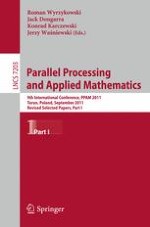This two-volume-set (LNCS 7203 and 7204) constitutes the refereed proceedings of the 9th International Conference on Parallel Processing and Applied Mathematics, PPAM 2011, held in Torun, Poland, in September 2011. The 130 revised full papers presented in both volumes were carefully reviewed and selected from numerous submissions. The papers address issues such as parallel/distributed architectures and mobile computing; numerical algorithms and parallel numerics; parallel non-numerical algorithms; tools and environments for parallel/distributed/grid computing; applications of parallel/distributed computing; applied mathematics, neural networks and evolutionary computing; history of computing.
